Pomona is a brand name of a low methoxyl pectin. Instead of needing sugar and acid to cause a gel reaction, it needs calcium. (See No Sugar Needed Pectins.)
The company is located in Washington State, USA. The product is actually made for them in Denmark.
- 1 How is Pomona different from other no-sugar-needed pectins?
- 2 What comes in a box of Pomona Pectin?
- 3 Pomona video
- 4 The calcium powder
- 5 The pectin powder
- 6 Shelf life
- 7 Using liquid stevia with Pomona’s pectin
- 8 Nutrition
- 9 Safety
- 10 Changing batch sizes with Pomona’s pectin
- 11 Pomona pectin recipes
- 12 Pomona Resources
- 13 Where to buy Pomona’s Pectin
How is Pomona different from other no-sugar-needed pectins?
Most other “no-sugar-needed pectins” contain other ingredients in addition to the pectin. For instance, Ball and Bernardin’s “No sugar needed” pectin contain added sugar in the form of dextrose, and have citric acid to them. Pomona instead is 100% pure citrus pectin extracted from the dried peel of lemon, lime, and orange. It’s kosher certified at the factory. It’s also vegan, gluten free, and GMO free, though it’s not certified organic at this time.
In addition, most other “no-sugar-needed pectins” only provide a very small handful of recipes, and warn you against deviating from the recipe, adjusting the recipe in quantity, or making up your own recipes. In contrast, Pomona provides hundreds and hundreds of recipes, allows you to scale batch sizes up or down, and gives you guidelines (in terms of both success and safety) for going “off-recipe” and making your own recipe.
Note as well that Pomona’s pectin can’t dissolve properly in a high-sugar environment. So if you do choose to use sugar with Pomona, which you may, you need to add Pomona to the recipe first before the sugar goes in.

Pomona Pectin Box Contents
Pomona Pectin is what is known as a “low-methoxyl pectin.” Here’s a brief video overview of low methoxyl pectin from PennState Extension. Note that Dr Martha Zepp (the main speaker) is holding a box of Pomona when she says it is “an acceptable choice” for making (jams) and jelly with less sugar.
What comes in a box of Pomona Pectin?
The box contains a large packet of pectin, a small packet of calcium powder, and a small leaflet of directions.
A 30 g (1 oz) box will do several batches of jam, making anywhere from 8 to 16 x ¼ litre (250 ml / 1 cup / 8 oz) jars, depending on the fruit or recipe. For jelly, you’ll get about half that number of jars, because it doesn’t have the volume of the mashed fruit in it.
You can also order Pomona pectin in bulk: in 225 g and 450 g (½ lb and pound) bags.
Pomona video
Here is a short video tutorial from one of the makers of Pomona’s pectin.
The calcium powder
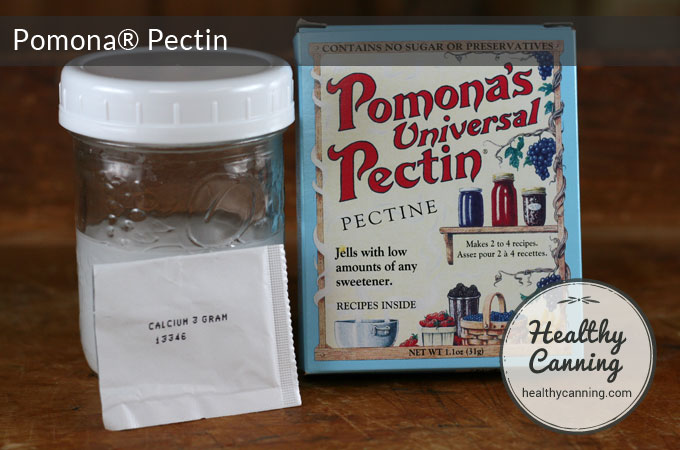
Pomona Pectin calcium water
Low methoxyl (LM) pectin such as Pomona needs calcium to activate it.
In theory, some fruits might have enough calcium in them to do the trick, but not all fruits, and besides, consumers aren’t going to know the chemical breakdown of every fruit. Consequently, Pomona supplies you with a small 3 g packet of calcium that you mix up with some water and add to the product you are making. It’s technically “monocalcium phosphate” powder, made from calcium and phosphorous.
To mix up the calcium water, the directions tell you to use ½ teaspoon of the powder from the small calcium packet. When you pour it into a half-teaspoon measure, and level it off with a knife the way Fanny Farmer taught us, it might look like the packet had ¾ teaspoon in it, but in fact, you are supposed to use the whole 3 g of calcium powder. That’s presumably ½ teaspoon in volume when pressed and settled down.
Mix that 3 g of calcium powder into 125 ml (½ cup) of cold water. Store this in a jar or sealed container in the fridge. It will last for many months and many uses. You can also freeze it then thaw as needed (and re-freeze.) Shake before using. (Tip: if you get the bright idea of using a small mason jar with a Ball / Bernardin lid on it, as shown in the photos here, it’s actually not such a great shaker — swish from side to side or water will come out the top.)
The calcium powder has an indefinite shelf life in the package, and a longish storage life mixed up and refrigerated, but discard if you see any mould or colours appearing in the mixture.
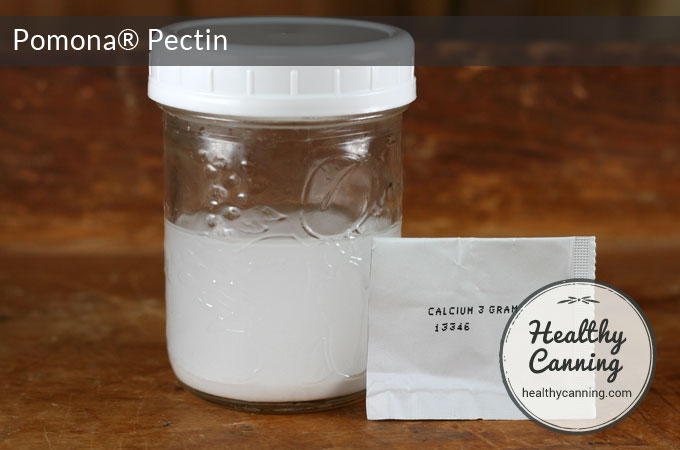
Pomona Pectin calcium water
The pectin powder
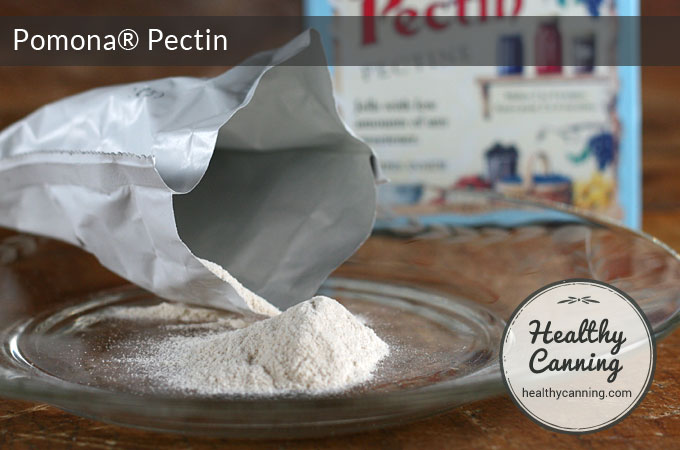
Pomona Pectin Powder
The large packet has around 30 g (or around 12 x 5 ml teaspoons) of pectin powder in it. Pomona says a teaspoon of it is 3 g.
The powder is quite slimy when liquid hits it.
Don’t mix Pomona’s directly with fruit, or the Pomona will clump. The Pomona must be pre-mixed into something before being added to the main mixture.
- Add it first to either a liquid sweetener that is no more than ¼ the amount of mashed fruit or juice, or, to an amount of dry sweetener if using that is no more than half the volume of mashed fruit or juice.
- For liquid sweetener such as stevia see below.
Unlike other pectin, you add Pomona’s pectin at the end of the cooking process, when your jam and jelly have been cooked in the pot.
After you add the Pomona’s pectin, do not cook the jam or jelly for more than a minute or two, or you will de-activate the pectin and get poor results.
Shelf life
The shelf life of the unused calcium powder and pectin powder is indefinite. Just store in a cool, dry place to prolong shelf life. Their website says, “Remember, Pomona’s Pectin keeps indefinitely. You can buy it in 2016, store it cool and dry in an airtight container, and continue using it in 2017, 2018, 2019, and beyond.” [1]Accessed Oct 2016 from https://www.pomonapectin.com/
The shelf life of the mixed up calcium powder with water, stored in a sealed container in the fridge, is at least several months usually.
The shelf life of jams, jellies and other products made from Pomona in unopened water-bathed jars on the shelf, is at least a year, subject to the USDA’s advice that for best quality, you should use home canned goods within a year. At the end of that year, don’t throw it out: just make sure it’s at the front of the shelf, to be used up first before other things.
Once you open a jar, store in the fridge, and try to use up within a few weeks. All lower-sugar jams and jellies become susceptible to moulds after opening.
Pomona says on their site,
The reason jam made with Pomona’s Pectin has a shorter shelf life is because it is low-sugar jam. A large quantity of sugar in the jam helps to preserve the jam “once opened.” According to the USDA, both high and low-sugar cooked jams need water bath canning in order to seal well and keep for 1 year on the shelf at room temperature before opening. But after opening, keeping time in the refrigerator is different. ….. That being said, it is possible the jam will last longer once opened, depending on how you treat it. For example, if it doesn’t sit out at room temperature for long periods and if you always use clean utensils when serving it. [2]November 2015, accessed at https://www.pomonapectin.com/faq/#comment-1460
Using liquid stevia with Pomona’s pectin
If your sweetener is liquid (aka concentrated) stevia, then do this with the pectin powder:
Bring 250 ml (1 cup / 8 oz ) of the fruit concentrate mixture or juice to a boil in a microwave. Then either:
a) put in a blender or food processor, add the pectin powder required, put lid on and blend for 1 to 2 minutes until it is all blended in; OR
b) put in a jar large enough to give you ample shaking room, put the lid on the jar tightly, and wearing oven gloves (against the heat) shake the jar vigorously. Let rest for a few minutes, then shake again. Repeat as often as needed to blend. You can also let sit overnight in jar if desired to dissolve further. Skim any foam off top before using.
Both blending suggestions come from the Pomona people.
However you blended it, then add it back to the main mixture.
As for when to actually add the liquid stevia, the Pomona’s website says,
When using concentrated stevia to add more sweetness to a jam or jelly sweetened with juice concentrate, add stevia to taste after you add the blended mixture of juice concentrate and pectin to the boiling fruit or juice in the pan.” [3] I am using concentrated stevia for my sweetener in a Pomona’s cooked jam or jelly recipe. How do I get the pectin to dissolve properly and not clump? Accessed June 2015 at https://www.pomonapectin.com/faq/i-am-using-stevia-for-my-sweetener-in-a-cooked-recipe-how-do-i-get-the-pectin-to-dissolve-properly-and-not-lump/
And remember, again, after adding the pectin, cook for only 1 or 2 minutes, then get your pot off the heat so you don’t ruin the pectin. You can always adjust the sweetness with your liquid stevia after the pot is off the burner — cooking is immaterial to the liquid stevia!
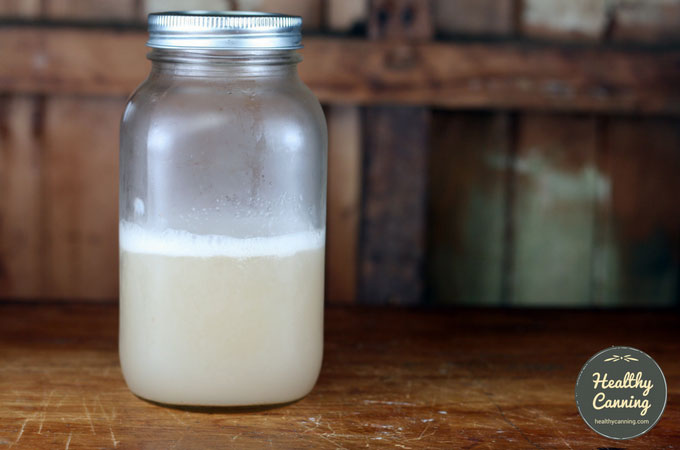
Pomona pectin powder shaken in a jar to blend it.
Nutrition
One teaspoon (3 grams) of Pomona’s Universal Pectin contains:
10.2 Total Calories
2.55 grams carbohydrate (from soluble fiber)
2.5 grams soluble fiber
90 mg sodium
In terms of Weight Watcher’s PointsPlus®, it’s 0 points per teaspoon up to 6 teaspoons, 1 point from 7 to 20 teaspoons.
Safety
Pomona’s has no citric acid added to it, as some sugar-free pectins do. “Other pectins have acid added to them; Pomona’s does not.” [4] Sumberg, Mary Lou. Blog post response. 24 July 2014. Accessed March 2015 at https://www.pomonapectin.com/faq/#comment-848 So for safety to prevent botulism and other nasties, it is mandatory that you add the bottled lemon or lime juice in the quantities specified by Pomona recipes. That is for health and safety; not flavour.
On the recipe sheet for jam, some fruits have an asterisk. That means that you need to add 4 tablespoons of lemon or lime juice (or 1 teaspoon powdered Citric Acid.) You need to do this to adjust the acidity (lower the pH) for canning safety, and sometimes, to get a gel. (They do note that in the case of pomegranate, it’s just for flavour.) Note: Ascorbic Acid won’t provide the safety of Citric Acid; don’t substitute.
We have a page on our website called Get Creative that gives you guidelines for converting a recipe. The one thing it doesn’t address, which applies to a recipe with zucchini in it, is the pH or acid level of the mixture and the final product. To be safe for water bath canning, the mixture must be high acid and the pH must be 4.6 or below, which many fruits are. But zucchini is a very low-acid fruit/vegetable. Other pectins have acid added to them; Pomona’s does not. That is why some fruits, in our recipes, require added lemon or lime juice or vinegar to be safe for water bath canning. And that is why it’s always important to follow a tested recipe if you want to store the final product on a shelf at room temperature.” [5] Sumberg, Mary Lou. Blog post response. 24 July 2014. Accessed March 2015 at https://www.pomonapectin.com/faq/#comment-848
Remember, just because you get a gel on the jam, and a seal on the jar, doesn’t mean it’s safe: remember the watermelon jelly botulism outbreak that occurred in Vancouver in 2011. So, use a tested recipe with Pomona’s.

It’s easy to make soft spreads with Pomona, but increasing the calcium water and amount of pectin you add to the recipe can harden the gel
Changing batch sizes with Pomona’s pectin
While most pectins have strict directions about not varying the batch size or doubling, tripling, etc, the batch of jam or jelly you are making, with Pectin there is no restriction: it is easy to vary the batch size.
If you do double or triple jam recipes with Pomona bear in mind:
- you will likely have to double or triple the simmering time
- use as wide a pot as you have, in order to help speed up evaporation [6] Pomona Pectin FAQ. Accessed March 2015 at https://www.pomonapectin.com/faq/
Pomona pectin recipes
Overall, for anyone looking to home-can low or no sugar (or alternative sweetener) jams, jellies, etc, it’s Pomona who has the greatest number of recipes to support their product.
As of summer 2017, there are over 150 recipes on Pomona’s web site, plus an additional 75 in their Pomona book.
So if you want a wide variety, you will likely want to consider Pomona.
Pomona Resources
Developing or Converting Recipes for Cooked Jam or Jelly Using Pomona’s Pectin
Troubleshooting a Pomona product that didn’t set
Pomona recipe sheet/ directions sheet that comes with every box
Where to buy Pomona’s Pectin
You can buy Pomona’s Pectin now in America, Australia, Canada, New Zealand and the UK. You can order directly from Pomona or one of its distributors, or, get it on Amazon.
In Australia, you can order it from Green Living Australia.
In New Zealand, you can order it from Lenabosa Farm.
References

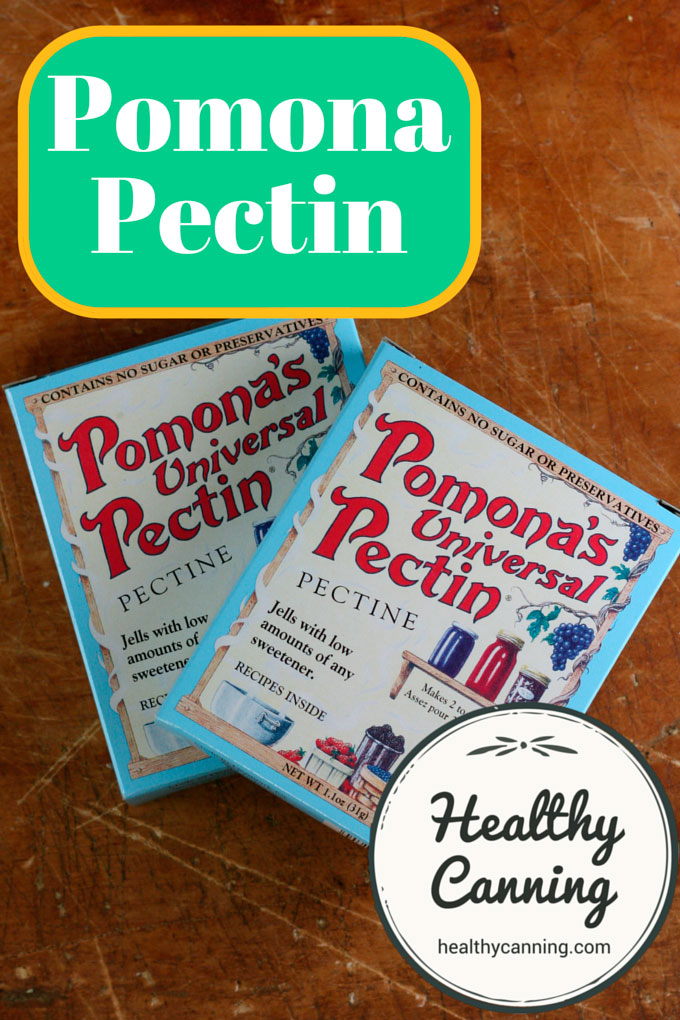
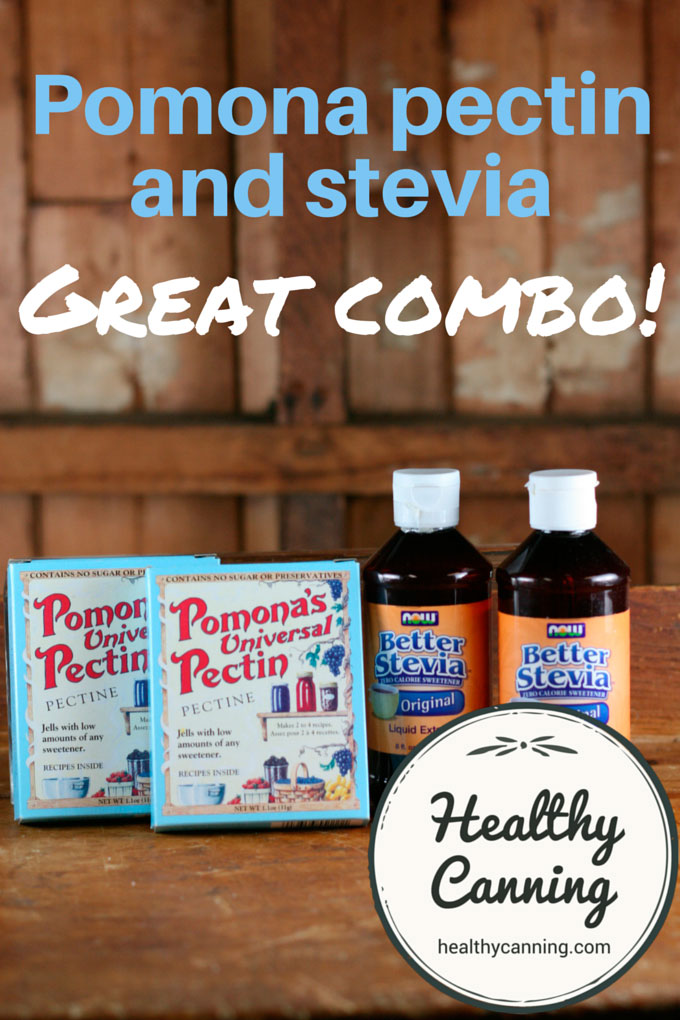
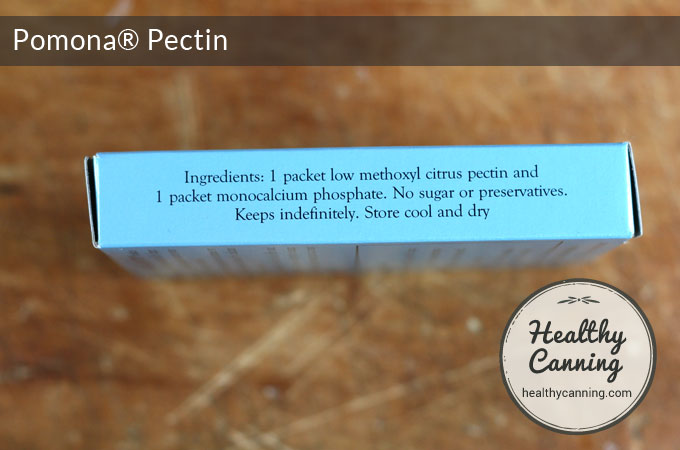
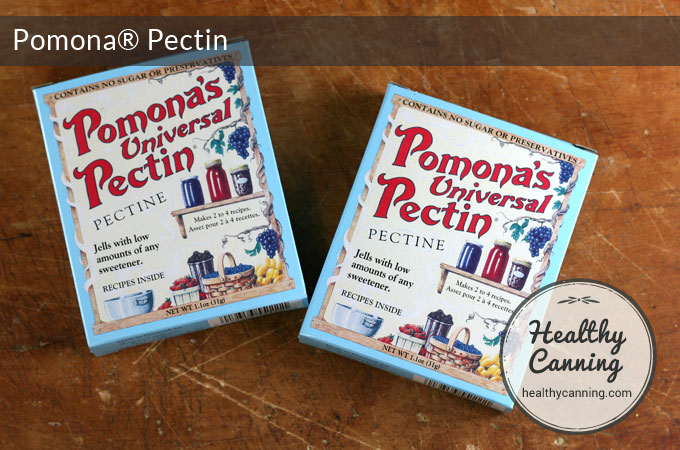

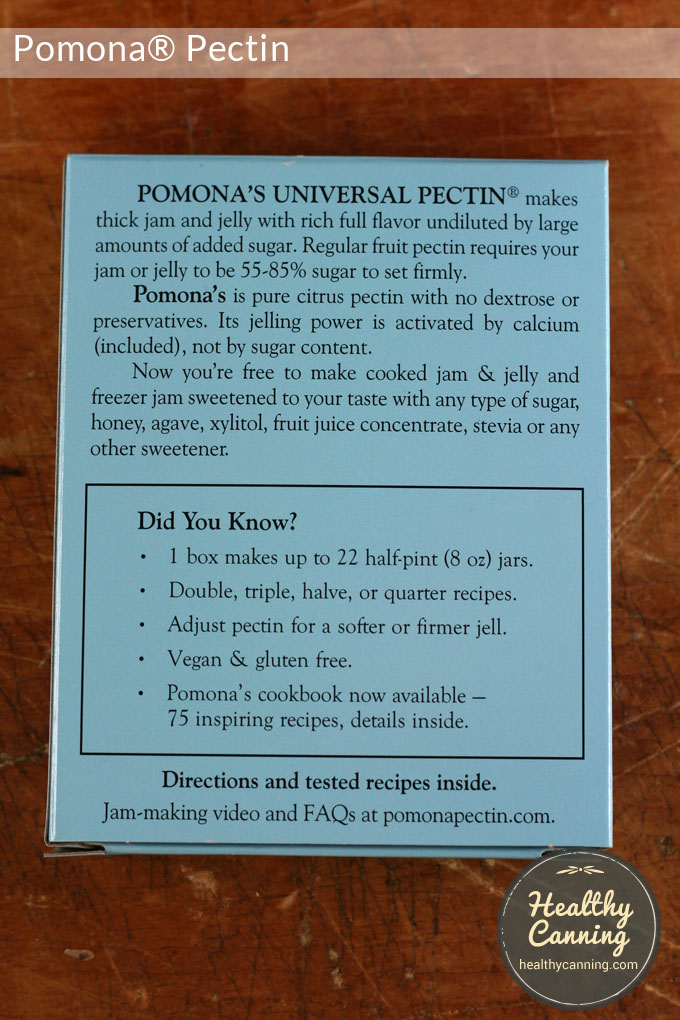


Kathy D.
I canned raspberries with Pomona Pectin. Man, what an experience! It was like cement! I mixed it with some of the light syrup to blend. Good luck with that! Whisking wouldn’t work. Used an immersion blender for over 15 minutes. Still lumps and clumps, I put into a ceramic bowl and using a spoon broke bigger clumps into smaller ones. The most time consuming part of canning was working with the pectin.
Christina
Hey,
I am living in Germany and can’t find a source for Pomona pectin here.
Would it be possible to use the recipes Pomona provides and that are posted here at healthycanning.com with a different low methoxyl pectin that I can get here in germany?
Chris Airey
Ivy House farm (Branwen’s kitchen) in UK will ship to Germany pay by Paypal – https://www.ivyhouseshipton.co.uk
Nikki lewis
Love this pectin! One of my absolute favorites!!!
Donna Hartmans
How can I obtain more monocalcium phosphate from Pomona’s?
I have plenty of pectin, but used up the MCP.
thanks
Healthy Canning
Contact Pomona directly: https://pomonapectin.com/contact/
Nina McBride
I like my jams to be without chunks and no or few seeds. To get this texture I put my berries through a hand grinder with screen called a “squeezo” made by Garden Way. The only problem with this method is that a lot of the natural pectin in the fruit is stripped away. Using traditional pectin powders results in a very loose jam (yummy but runny). Would using Pomona brand open up a way for me to tighten the jam up just a bit?
Nina
SHARI MEIER
Where can I purchase more of the monocalcium phosphate?
Healthy Canning
Contact Pomona and they’ll direct you.
Prof Dr Ali BATU
Dear Sir / Madam,
For years, I have been giving lectures on jam and marmalade production techniques and technology in Food Engineering Departments in Turkish Universities. Now I’m retired from public universities and providing free consultancy services to Food Production (especially fruit and vegetable processing) factories. Especially jam producing companies are producing low energy jam while using preserving additives. I would like to propose them producing low-energy jam using POMONA pectin without the use of preservative additives. I saw your product on the internet and liked it. I also guessed that this product is not well known or widely not used in Turkey. I would like to advise them your company and your products in this regard and I would like to markets your products in Turkey. What can we do about it and how can we collaborate, or what would you suggest me?
Yours truly
Prof. Dr. Ali BATU
Healthy Canning
Hello Dr Batu, you would want to contact Pomona directly.
Kristianna
If I didn’t already know how to use Pomona’s Pectin, this would be my go-to article on that information. WOW! You really spent a lot of time putting this post together with all the photos. I just want to say, “Thank you!” Happy Canning.
K
Melodee Hooper
I am growing my own stevia plants. Suggestions on how to use that instead of the stevia you buy in the store. I like it much better. Not as concentrated and no lingering taste when you eat it.
Healthy Canning
Sorry no suggestions on how to prepare it for use from scratch.